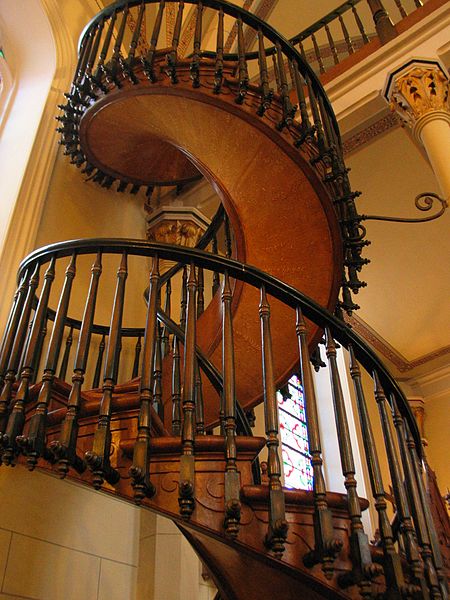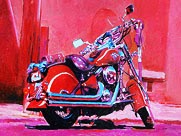 |
| The Loretto Chapel by Tom Mallon |
The Landmark
The chapel was designed by French architect Antoine Mouly, using what was then described as Gothic Revival architecture. Construction of the chapel began in 1872 and was completed in 1877 (relatively modern by Santa Fe standards). Once in use, it became obvious that a stairway to the choir loft had been overlooked. This dilemma would eventually result in the then named "Our Lady of Light Chapel" becoming home of the "MiraculousStaircase". Click here to view complete painting with details.
The miracle involves the sudden appearance of a completed staircase to the choir loft after the chapel had been built and consecrated. Upon discovering the staircase, the good sisters of Loretto came to the somewhat rushed conclusion it had been built miraculously by none other than Saint Joseph the carpenter (of Jesus, Mary and Joseph fame). The stairs have also been called miraculous because there is no supporting central beam.
The chapel was designed by French architect Antoine Mouly, using what was then described as Gothic Revival architecture. Construction of the chapel began in 1872 and was completed in 1877 (relatively modern by Santa Fe standards). Once in use, it became obvious that a stairway to the choir loft had been overlooked. This dilemma would eventually result in the then named "Our Lady of Light Chapel" becoming home of the "MiraculousStaircase". Click here to view complete painting with details.
The miracle involves the sudden appearance of a completed staircase to the choir loft after the chapel had been built and consecrated. Upon discovering the staircase, the good sisters of Loretto came to the somewhat rushed conclusion it had been built miraculously by none other than Saint Joseph the carpenter (of Jesus, Mary and Joseph fame). The stairs have also been called miraculous because there is no supporting central beam.
In reality, the residing Bishop, Jean-Baptiste Lamy, had ordered the stairway to
be constructed offsite (it was, after all, a sanctified chapel in use) utilizing the services of a French carpenter named Francois-Jean Rochas.
Rochas chose a concentric helix design over a spiral one requiring
a central beam, as he no doubt felt the former could be constructed and installed as one
piece. The concentric helix design requires considerable skilled labor and special equipment, as the curving wood panels would have to be steamed at high temperatures. It's quite possible the staircase was delivered from well outside the New Mexico area.
Unfortunately, Francois-Jean Rochas was murdered not long after the stairs were installed so he was never available to contest the miraculous construction or its sudden appearance. Ironically, his body was laid to rest in the Lady of Light Cemetery in La Luz, NM, where his headstone can be viewed today.
Meanwhile, Bishop Lamy was apparently pleased to have a miracle in his archdiocese, for he never bothered to dispel the myth. As a nun once said... "If it saves even one soul, its a miracle".
 |
| A truly amazing piece of carpentry |
Unfortunately, Francois-Jean Rochas was murdered not long after the stairs were installed so he was never available to contest the miraculous construction or its sudden appearance. Ironically, his body was laid to rest in the Lady of Light Cemetery in La Luz, NM, where his headstone can be viewed today.
Meanwhile, Bishop Lamy was apparently pleased to have a miracle in his archdiocese, for he never bothered to dispel the myth. As a nun once said... "If it saves even one soul, its a miracle".
 |
| Highly decorative pinnacles |
Divine intervention or not, the building itself remains a bit of a miracle. It's an incredibly beautiful example of Gothic Revival architecture, complete with stone buttress columns, topped with spires and decorative carved pinnacles, detailed stone edging, arched portal stained glass, a generous rose window and one smaller rose portal. You would be hard pressed to find a more elaborate or beautiful chapel anywhere. Along with the incomplete Romanesque style Saint Francis Basilica, just a couple blocks away (appearing in the painting as a detail to center far left), they are the only two structures of their type in all of Santa Fe. Both buildings appear in contrast to the dominant style of adobe architecture typically found in the desert paradise known as Santa Fe.
 |
| St. Francis Basilica to left of Loretto Chapel |
 |
| Vertical Pyramid Composition |
Unlike horizontal canvases, where a viewer's vision can be forced vertically or horizontally, a vertical canvas, with few exceptions, will initially limit a viewer's eye movement to just up and down. The Loretto Chapel canvas is 24 inches wide by 48 inches in height and, with its gothic structure, is a good example. It creates a vector driven vertical shape within a vertically shaped canvas. Click here to view complete details of the painting.
Besides the building itself, the three main anchor objects are the two rose windows (large and small), the bystander (with helmet) and the motorcycle in the bottom right. These items not only balance the composition, they also provide a forward perspective, driving the viewer back onto the building.
|
|
Got Feedback?
Comments? Questions? Corrections? Any feedback at all? Just click on the comments box at the bottom of this page and enter your thoughts. All comments are welcome.
Santuario de Guadalupe, the oil painting by Tom Mallon. This 42" x 22" canvas is the latest addition to the Santa Fe Portrait Series. The Santuario is the oldest shrine to Our Lady of Guadalupe in the US.
Visit this later update by CLICKING HERE
Shostakovich and Cultural Snobbery, Could anyone survive Stalin's Purges, compose a large body, write for himself and the masses while producing constantly great work?
Visit this later update by CLICKING HERE
Tom Mallon's website "MallonArt". This website will provide you with links to all his paintings, drawings and other artwork portfolios, including the ongoing series entitled the Santa Fe Portrait.
Visit this later update by CLICKING HERE




Concerning the miraculous staircase I want to tell of my visit. It was sometime in the 1970s when I first learned of the staircase in an article in the Reader's Digest. I was enthralled at the idea that there was a miraculous site right in our backyard here in America and was determined to go t o see it. My friend and I began to plan a trip...we got our husbands to agree to babysit the kids for a weekend and we looked into all different ways to get to and from Santa Fe ...plane, train, bus and car, however, it became obvious that there was no way we could make the trip in just a weekend. Eventually, sadly, we had to abandon our plan. Fast forward 20 years and our family moved from California to Ontario Canada, and over the next few years we made numerous motorhome trips back and forth, along interstate 40. Each time I would see the sign for the exit toward Santa Fe (about 100 miles), I longed to take the detour, but the timing just wouldn't work. Then one year, as we traveled along after a long day of driving, it was about 10 o'clock when we approached the turnoff. I asked hubby if we could go...said it would only be a couple of hours detour, that we had to stop for the night soon anyway, and I would do the driving if he was too tired. He agreed, and off we went! When we approached Santa Fe, a sign said " Santa Fe next 7 exits". We just chose one, because we had no idea where the Church was, it was near midnight, and we just needed to park and get some sleep. The road we found ourselves on was dark and seemed like the outskirts of the city...no place to park or even to ask directions! Then suddenly we came across a large Church with a big parking lot and decided it wouldn't hurt to park there overnight. The next morning we started off early to find the staircase. Soon we came to a "T" and blindly chose a direction to turn. It was the correct choice and soin we found ourselves in the old downtown area of the city. The streets were getting narrower and difficult for a large motorhome, and of course, we didn't have any idea of where the Church was. Hubby was getting stressed, so I noticed a side street where there was a parking spot and suggested that he pull in there. He could get the kids up and have breakfast while I would go to find a phone booth and call the local Catholic Church to ask directions. I stepped out onto the sidewalk and was looking around for a phone, when I noticed a small sign behind me....we were parked directly in front of the Chapel with the Staircase!!! It was 7:55 am and it opened at 8! We had a wonderful visit to the Chapel, marveled at the sight of the the awesomely beautiful majestic staircase, and learned that it had been in daily use for a hundred years with no sign of wear on the wooden steps! We carried on with our journey to California knowing we had just experienced a wonderful, sweet little miracle from Heaven!
ReplyDelete